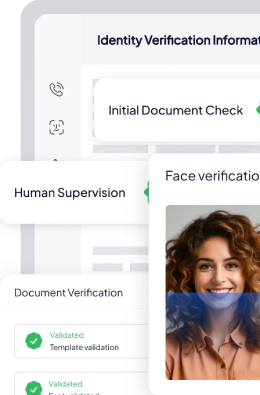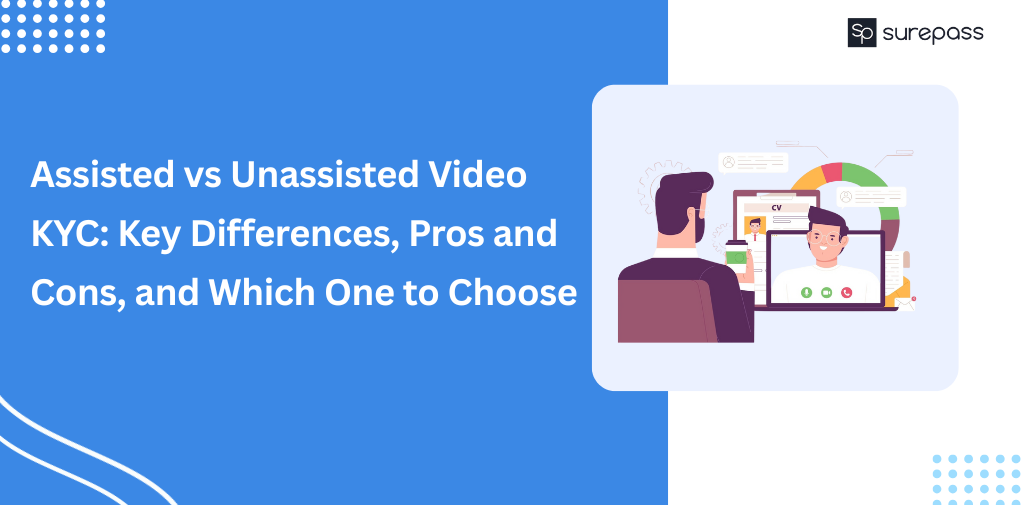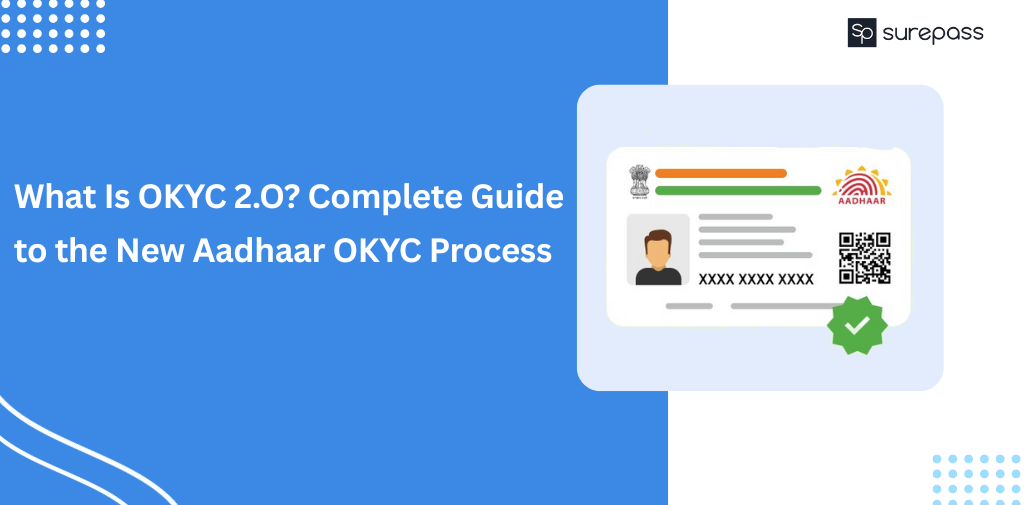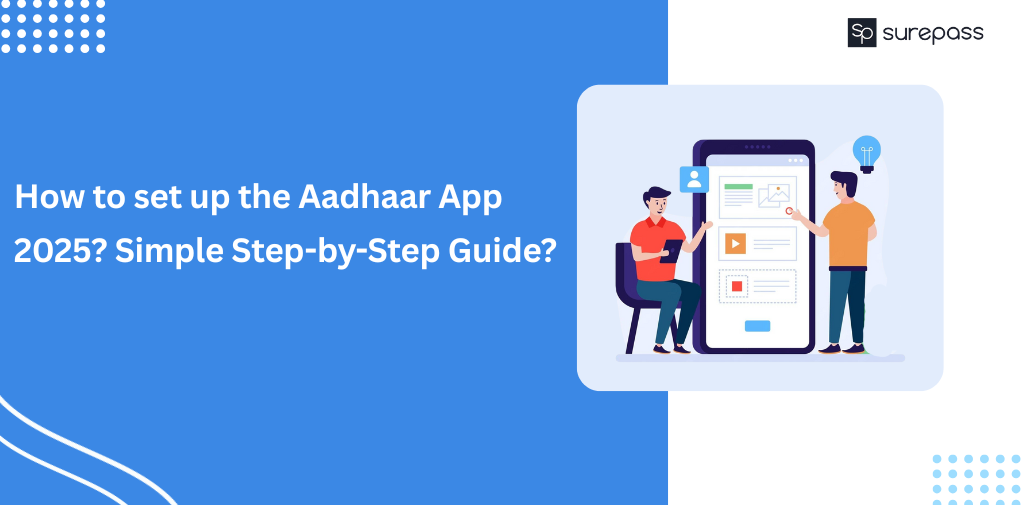Video KYC (Know Your Customer) is an online KYC verification process. It helps businesses verify customer identity remotely through a secure video interaction. It eliminates the need for physical document submission and in-person verification. This makes customer onboarding faster and more convenient without compromising rules and regulations.
Now, businesses are choosing Video KYC, which reduces operational costs. It enhances the user experience and prevents fraud. There are two primary approaches to KYC: Assisted and Unassisted using AI.
Here, in this blog, you will learn about the key differences between assisted vs unassisted Video KYC.
Assisted vs Unassisted Video KYC: Key Takeaways at a Glance
- In assisted Video KYC, an agent is required for live online verification.
- Unassisted video is a fully automated video through AI. It offers faster, cheaper onboarding for high-volume businesses.
- Choosing the solution depends on the industry, risk appetite, and compliance requirements.
What is Video KYC?
It is an online process that helps businesses verify customer identity through a secure online process. It is a real-time video call or recorded video uploads. It confirms that the documents are legitimate. The person is physically present during the video call.
RBI, SEBI, and IRDAI mandate Video KYC for all financial institutions with KYC and AML. It prevents identity fraud and maintains secure onboarding.
Automate your KYC Process & reduce Fraud!
We have helped 200+ companies in reducing Fraud by 95%
What is Assisted Video KYC?
Assisted Video KYC is a customer verification process where a live agent interacts with the user over a secure video call. In this process, the agent helps the customer through the entire process. It confirms compliance with regulatory norms and minimizes the chances of errors and fraud.
How does it work:
- In this process, the customer schedules or initiates a secure video call through the bank or financial institution’s platform.
- A trained agent joins the call to verify the customer’s identity in real time.
- The agent asks the customer to display their government-issued ID, and sometimes a secondary document.
- The agent asks questions of the customer to confirm liveness.
- This entire session is recorded for audit and compliance purposes as per the RBI or other regulatory guidelines.
What is Unassisted Video KYC?
Unassisted Video KYC is a self-service online verification process. Where customers complete their Know Your Customer (KYC) requirements without any agent involvement. This whole process is automated and carried out by AI technologies. It also includes facial recognition, liveliness detection, and document verification.
How does Unassisted Video KYC Work?
- Customer Initiates the Process.
- The customer uploads government-issued identification documents, such as Aadhaar, PAN, and a passport.
- The system prompts the customer to record a short video, often asking them to perform actions.
- An AI algorithm verifies the document details, does face matching, and detects any signs of spoofing or fraud.
- Once the checks are passed, the system approves the KYC in real-time or within minutes.
Compliance and Security Considerations
It is necessary for every business to follow the regulations. It should maintain the highest security standards to protect customer data.
RBI, SEBI, and IRDAI guidelines for Video KYC
- RBI: Banks and NBFCs must conduct Video KYC as per the RBI’s Video-Based Customer Identification Process (V-CIP) guidelines.
- SEBI: SEBI makes it mandatory to conduct secure video-based KYC for stockholders and market intermediaries.
- IRDAI: Insurance providers can use Video KYC for customer verification. The provided process is recorded and stored securely.
These guidelines require liveness detection, geo-tagging, and recording of sessions for audit purposes.
Data Encryption and Liveness Detection
- Encryption: All video streams, documents, and data transfers must be end-to-end encrypted to prevent breaches.
- Liveness Detection: AI-powered liveness checks ensure the person is physically present and not using static images or deepfakes.
Pros and Cons Assisted vs Unassisted Video KYC
Assisted Video KYC
Pros:
- Strong Compliance: Human involvement confirms compliance with RBI, SEBI, and IRDAI regulations.
- Human Involvement: It reduces errors in identity verification and document checks.
- Ideal for High-Risk Transactions: Suitable for banks, insurance companies, and businesses handling large-value transactions.
Cons:
- Higher Cost: Requires agents and increases operational expenses.
- Slower Process: Onboarding speed depends on agent availability. It can delay customer verification.
Unassisted Video KYC
Pros:
- Cost-Effective: It eliminates the need for live agents and reduces costs.
- Faster Onboarding: AI-powered verification completes in minutes.
Cons
- AI-Dependency: It relies on the accuracy of automated systems. It can lead to errors in certain edge cases.
- Advanced Fraud Detection Requirement: It needs liveness checks, face matching, and document verification to prevent fraud.
Assisted vs Unassisted Video KYC: Which one Should You Choose?
Assisted Video KYC is best for businesses in highly regulated sectors (like Banks, NBFCs, Insurance Companies) and those handling high-risk or high-value transactions, where manual verification is mandatory.
Unassisted Video KYC is ideal for businesses that need to deal with low to medium-risk customers and prioritize cost efficiency and speed (such as fintech apps, digital wallets, low-value loans, and mutual funds).
Conclusion
Unassisted and assisted Video KYC offer a secure, online alternative to traditional authentication methods. Assisted Video KYC ensures strong compliance as well as manual verification. This makes it suitable for industries with strict regulations and high-risk transactions. However, the non-assisted Video KYC provides speed, scaling, and efficiency. The best choice between Assisted vs Unassisted Video KYC is based on your business’s model as well as regulations.
FAQs
Ques: What is the difference between eKYC and Video KYC?
Ans: eKYC is an Aadhaar-based, automated, real-time process for identity verification using OTPs. Video KYC is a live video interaction between a customer and an agent.
Ques: Can we open a bank account without Video KYC?
Ans: Yes, you can open a bank account without Video KYC by applying for the Basic Saving Bank Deposit Small Account (BSBDA).
Ques: Is it safe to do Video KYC?
Ans: Yes, it is safe to do Video KYC.
Ques: What is the alternative to Video KYC?
Ans: The traditional KYC, eKYC, and offline KYC an alternatives to Video KYC.
Ques: Which is better digital KYC or Video KYC?
Ans: Video KYC is better than digital KYC.





